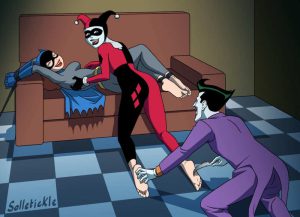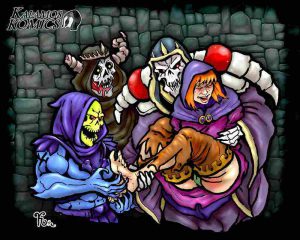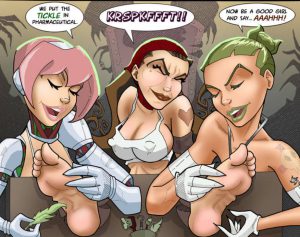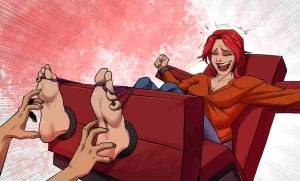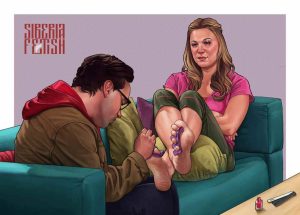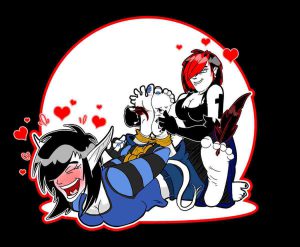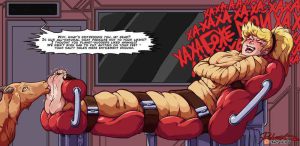Contents
- 1 1) Do you want to tell us something about yourself and your art?
- 2 2) What techniques do you use for your pics? Do you have a favorite artist that inspires you?
- 3 3) How much was the passion for stories? And the one for the tickle?
- 4 4) What are the tickling scenarios that you prefer to draw?
- 5 5) What are the aspects of tickling that you intend to represent with your craft? Example: the laughing, the wriggling, the relationship between tickler and ticklee?
- 6 6) Online there are countless photos and videos of tickling sessions. In your opinion, what do illustrations offer more than images of real scenes?
- 7 7) In your opinion, what makes tickling so interesting for fans of this phenomenon?
- 8 8) What are your works of which you are most proud?
- 9 9) Do you have any particular artistic goals for the future?
- 10 10) Do you think AIs will end up enriching or impoverishing the art of tickling representations?
1) Do you want to tell us something about yourself and your art?
Hello there!
The name is Peach, TicklishPeach. Well, not really. I’d rather not give away any information about my private life. Just be aware that I am a European, non-English, writer and photographer who encountered the tickling community when he was very very young. We are talking about the first years of the 2000s. I was there for the TicklingMediaForum heyday and before TickleTheatre was gone.
Leggi tutto: Tickle Artists #31: Interview with TicklishPeachI don’t even remember how old my DeviantArt account is. I remember shuffling from nickname to nickname. Like Tickling1234, TickleWoman and so on.
But I think this last one suits me quite well!
I love writing tickling stories, situations, and perils as there is always a new and exciting way to retell how a simple feather can make a character roll on the floor laughing and yield surrender.
That said I can’t deny that a big amount of likes, in the last weeks, came when I started to experiment with AI-generated pictures.
And I know, in these days, it is quite a controversial topic.
Don’t worry. We’ll get to that.
2) What techniques do you use for your pics? Do you have a favorite artist that inspires you?
This is a strange point to discuss. As I said, I’m mostly a writer and a photographer. When I do those, the best skill in my arsenal is just plain brainstorming. Thinking of different scenarios to describe or character types I’d love to see get some tickling.
That to me also is applicable when using AI.
Starting out I know in my head what is the specific result I want to get. Then I force the tools to reproduce it, like I was commissioning an artist by changing the image one step at a time.
So. As for the tools. I tested the most famous AI models in many different ways with hundreds and hundreds of different prompts. That was to understand how the actual language of these tools work and how to get around most restrictions.
Other than that I also use tools like Photoshop, Luminar, Swapface, and so on. That’s because I consider these AI pics more like constructs that need to be polished, either by generating more variations or cleaning them by hand.
Believe me, if you want to generate something nice it takes many more tries, time, and patience than it seems.
As for my favorite artists…there are so many of them. I love the classics like RalftheRalfMan, Bad_Pierrot, BlackProf, Scavenger and many many more. They are really too many to count.
3) How much was the passion for stories? And the one for the tickle?
Even though I can’t draw very well, I always tried to brainstorm ideas for tickle scenarios, characters, or archetypes I would have loved to see tickled.
As for when the tickle fetish started, I believe it happened, like for many other fellow fetishists, in early puberty. After seeing many tickle scenes on the television and in movies, and being over-exposed to female feet, my brain mixed those things together and I started loving them.
As for the scene that made me who I am, I think the biggest culprit is Disney’s Tarzan’s tickle scene. We all know the one.
Also, the Olive Oyl’s ones are pretty close.
4) What are the tickling scenarios that you prefer to draw?
There are many scenarios I like, but most of them can be distilled in a simple formula.
‘I love tickle scenarios when the ticklee is not supposed to laugh or be tickleable at all.’
That is quite a golden rule that I think is behind some of my favorite art pieces. Goth girls who are forced to laugh and not be so moody; anchorwomen tickled under the desk during a live event; a ticklish queen that is taken down by a frenzied audience who wants to put her in stocks; a powerful amazon warrior that is rendered useless in battle by…well stuff like that.

5) What are the aspects of tickling that you intend to represent with your craft? Example: the laughing, the wriggling, the relationship between tickler and ticklee?
If we are talking in general, I love to experiment with strange styles that nobody uses, like old paintings from the renaissance. Or ticklees that see little to no use by other artists. A good example are the pieces I generated with Callisto Yew from Ace Attorney and Sue Bergman from Hollywood Monsters. A couple of incredible characters that saw no art at all until my ‘intervention’.
6) Online there are countless photos and videos of tickling sessions. In your opinion, what do illustrations offer more than images of real scenes?
Simply put, they are different mediums. When you search for some videos, I think, you just want to chill and see the ticklee get destroyed for a longer period. It is cathartic and can give you a rush to see all that, supposedly, real reactions from them.
If you search for an illustration, I think, you are searching for a starting point for your imagination to fill in the gaps of before and after the moment represented.
That’s why I love tickling fiction so much. It gives you the basics to make your mind do incredible things.
7) In your opinion, what makes tickling so interesting for fans of this phenomenon?
The thing I like most about tickling is its versatility. If we tell a story, tickling can be used as an interrogation method that passes by non-fetishists and arouses us ‘people of culture’ in the same way. It can also be a playful act between friends that have chemistry or a powerful tool to take any powerful character and render them useless.
At least in fiction, no one is safe from such harm.
It’s a pleasant feeling.

8) What are your works of which you are most proud?
One piece that was unexpectedly popular, at least to me, was the one I dedicated to Paris Carver, one of my favorite Bond girls.
Mostly because It’s a simple sole shot with a backstory I wrote myself. And I saw many people liking it.
That said, I think the pics I love more are the ones that are spy-themed. A story genre great for tension-building and drama and for ticklish situations and interrogations as well. Since I’m a big James Bond fan, I was ecstatic to see them gather so much attention.
9) Do you have any particular artistic goals for the future?
As this is not my real job, but a side activity, I hope to continue generating pics for everybody to enjoy and write some good fiction for anyone willing to read it.
10) Do you think AIs will end up enriching or impoverishing the art of tickling representations?
I think AI-generated pieces, at least of the general public, are kinda misunderstood.
If you follow my example, I think AIs are following the same pattern drawn by digital renders, photos, videos, and all new techs. To some extent, all of these things, for someone who can draw traditional art is ‘kinda cheating’.
However, they all take different levels of skill and time to master and take you to very different results.
I don’t think these tools are really in any way in conflict with each other.
At least to me nothing can substitute an original Kusujinn piece or a Scavenger dark and moody illustration.
I see AI as a tool to free the repressed phantasies that, as of now, were only present in my writing or in my thoughts. To mishmash characters with styles that were never meant for them

